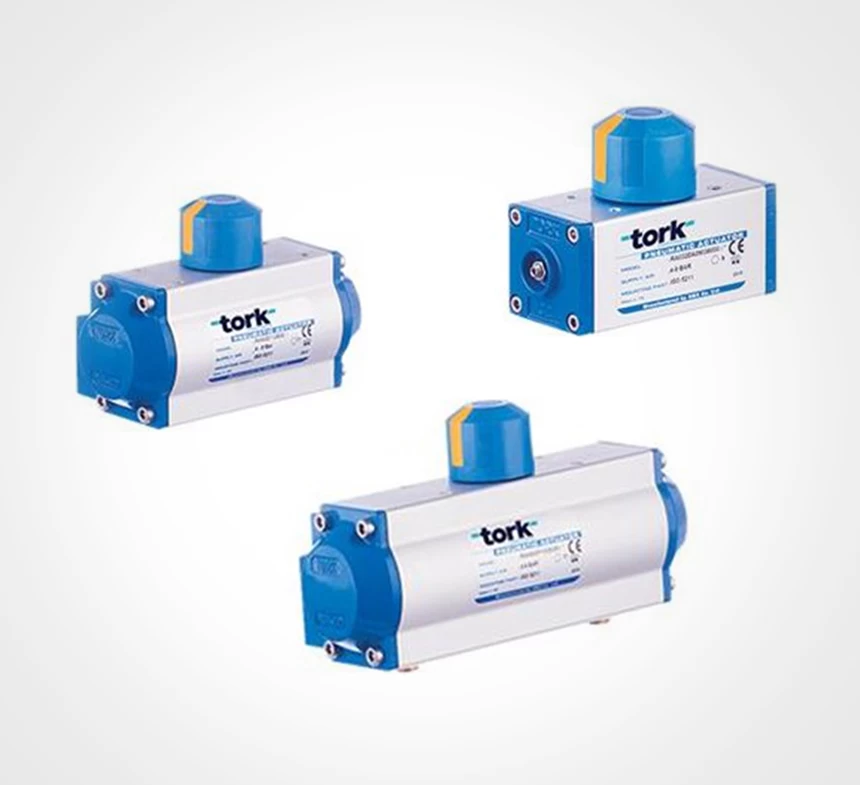How to Choose a Pneumatic Actuator? What Is Considered? Things to Know About Pneumatic Actuator
Pneumatic actuators work with compressed air force. It also works with pressurized gas if needed. Generally, 90 degree final control elements such as butterfly valves, ball valves and plug valves are used for on-off and proportional control purposes.
Features to Consider When Choosing a Pneumatic Actuator
- Whether the actuator is double acting/single acting or three position
- Actuators with 120 degree and 180 degree rotation
- If it is a hygienic process, choosing the appropriate actuator
- Actuator torque value at P=6 bar Nm output
- The torque value of the valve to which it will be connected, in Nm
- Line pressure max. min. fluid temperature
- Valve connection size, and threaded / flanged connection
- Opening and closing frequency of the actuator
- Rotary / Linear type actuator
- Namur valve/direction valve operating voltage
- Will the limit switch box be used?
- Control type on-off/ proportional
- Bottom hole square dimension of the actuator shaft
- Ball/ butterfly/ plug type and number of ways of the valve
- The viscosity of the fluid
- Actuator with torque more than 25% valve torque is selected
- Single acting (spring return) actuators should be selected according to the small torque value.
- ATEX certified, -50 C working environment
Which Type of Actuator Is Right for Your Process?
One of the pneumatic actuator types is selected by considering the application, fluid and environmental factors in which the actuator will be used. After the selection is made, the optional features are checked.
TORK Pneumatic Actuator Optional Feature
TORK actuator (standard production)( -20 C...+80 C)
Actuator that can withstand high temperature ( -20 C...+150 C)
TORK actuator operating at very low temperature ( -50 C...+85 C)
Epoxy painted actuator body (For aggressive media)
Teflon coated actuator stem (For aggressive media)
AISI 304 stainless pinion gear (For aggressive media)
Actuator with PVC body (For aggressive media)
Stainless steel body pneumatic actuator (For aggressive media)
ATEX certified pneumatic actuator (For aggressive environment)
Scotch yoke type actuators (for gas over oil applications)
Actuators for food and hygiene applications (For dairy, beverage and filling systems)
Operation of TORK Pneumatic Actuated Valve
Generally, the preferred actuator type is standard type and double-actuated rotary pneumatic actuators.
Pneumatic actuators are used for opening and closing butterfly valves, ball valves, plug valves and dampers.
Pneumatic actuator valves do the on-off function in two ways:
1. With on-off control (Namur solenoid valve and 1/4"-5/2 or 3/2 single coil valve are used to provide this control.)
2. With Proportional Control (Rotary electro pneumatic positioners or Rotary pneumatic pneumatic positioners are used)
In the selection of pneumatic actuators, the characteristics of the valve to be controlled should also be examined.
This valve should be a valve that turns 90 degrees to fully open and fully closed positions. Such valves are ball valves, butterfly valves and plug valves.
1. The torque value required for opening and closing the valve is determined as Nm.
2. 25% more of the torque value of the valve is added as a safety factor.
3. The equivalent of this value is found in the TORK actuator catalogue, with the output torque value of the actuator at P: 6 bar as Nm (corresponding to the safety coefficient of the valve to be controlled). The actuator type at this value opens and closes the selected valve only with 6 bar control air pressure.
4. The valve's stem output must match the actuator's stem (pinion gear) seat (square or star shaped). In cases where it does not fit, it is necessary to use an interconnection and adapter. Valve-actuator connection flange and actuator-valve connection holes are in ISO 5211 standard. Pinion gear bottom hole is also standard.
If the valve shaft output dimensions are also standard, there will be no problem. But this is something that should definitely be controlled.
Double acting actuators are controlled by 1/4"-5/2 single coil namur directional valve or double coil namur directional valve.
Single acting (spring return) actuators are controlled by a 1/4"-3/2 single coil namur directional valve.
3-position pneumatic actuators are controlled by a special TORK group directional valve.
Stroke adjustment in pneumatic actuators; It is made with two stroke adjustment bolts located on the actuator body and the upper part of the namur valve. On request, stroke adjustment bolts can be added from the covers. Thus, double-sided stroke adjustment is provided. But the standard is; It is to adjust the stroke with the stroke adjustment bolts on the body.
Why is the stroke adjustment done?
When the actuator is attached to the valve, the valve ball may not always close with a full ninety degree turn. It can also be caused by the clutch or the valve stem. In such problematic cases, stroke adjustment buttons are used so that the actuator closes the valve completely.
Single acting (spring return) pneumatic actuators; it is mostly used in processes that require safety. Single acting actuators are generally preferred in gas lines or fire lines. The reason is, spring return actuators are preferred to return the valve to its initial position if the control air is somehow cut off.


